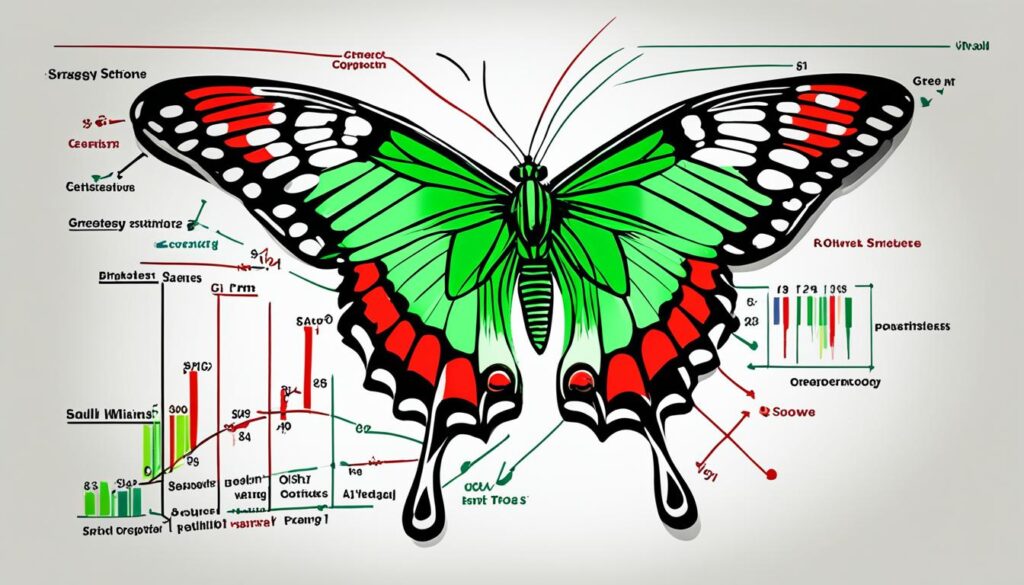Advanced Options Strategies: Exploring the Broken Wing Butterfly

Did you know a special options strategy can lead to a maximum profit? This profit is equal to the width of its narrower spread plus any credit received or minus any debit paid1? Welcome to the world of broken wing butterflies. Here, traders use a unique strategy to improve their risk-reward profiles in options trading.
The broken wing butterfly is an advanced strategy. It changes the standard butterfly spread by using three strike prices. This makes it flexible, working as either a debit or credit trade. It’s for traders who know where prices will move and want to manage their risks better in options trading.
In stable markets with little expected movement, the put broken wing butterfly works well. It benefits from time decay and limits downside risk2. But, it’s risky in volatile markets. Traders must watch the market closely.
Let’s look at a real example. A broken wing butterfly was set up with a net debit of $0.25. It could make a maximum profit of $4.75 and risk $5.25, less commissions3. This shows how broken wing butterflies can offer asymmetrical risk-reward scenarios for advanced options traders.
Key Takeaways
- Broken wing butterflies modify standard butterfly spreads for better risk-reward profiles
- The strategy can be set up as either a debit or credit trade
- Maximum profit is determined by the width of the narrower spread and credit/debit
- Put broken wing butterflies are suited for stable markets with minimal expected movement
- Time decay generally works in favor of the trader, especially near expiration
- Effective management requires monitoring market conditions and potential adjustments
Understanding the Basics of Butterfly Spreads
Butterfly spreads are complex trading strategies that have a unique risk-reward profile. They offer a special way to trade options. Let’s explore how they work and their uses.
Definition and Structure of Standard Butterfly Spreads
A butterfly spread has three strike prices in a 1x2x1 ratio, using all calls or all puts. You buy one option at a lower strike, sell two at the middle strike, and buy one at a higher strike45. This setup forms a symmetrical pattern, like butterfly wings4.

Risk and Reward Profile of Butterfly Spreads
The risk and reward of a butterfly spread are unique. You make the most money if the asset price ends up at the middle strike at expiration4. But, you could lose the most if the price goes past the outer strikes4. This makes butterfly spreads appealing for traders who think the price will move little.
Common Applications in Options Trading
Traders use butterfly spreads in different market conditions. Long butterflies work well in low-volatility markets, while short butterflies do better in high-volatility ones5. You can also adjust the strategy, like making broken wing butterflies for credit spreads4. But, these changes can increase risk and need more margin4.
Butterfly spreads are a sophisticated way to trade options. They balance potential rewards with known risks. Knowing how they work and when to use them is key for traders wanting to grow their options trading skills.
The Broken Wing Butterfly: A Unique Twist on a Classic Strategy
The broken wing butterfly is a special kind of options strategy. It’s also known as an unbalanced butterfly or skip-strike butterfly. This strategy changes the classic butterfly spread by using different strike prices. This makes the position not symmetrical, offering unique benefits.

Usually, a butterfly spread has a 1:2:1 ratio of contracts. The broken wing butterfly keeps this ratio but makes the wings not the same size. This lets traders bet more on direction6. It can turn a spread that costs money into one that makes money at the start, with still a chance to profit.
Choosing the right strike prices is key. By picking different strike widths, traders can aim for more profit if they guess the market right6. This change affects the position’s delta, helping traders make the most of market moves6.
A big plus of the broken wing butterfly is it keeps value if the stock goes past the lowest strike. This safety feature is not found in regular butterflies, offering more ways to manage risk6.
When making a broken wing butterfly, picking the right strike prices and costs is very important. These choices set the risk and aim to maximize profit at the short strike6. The strategy’s unique wings match the trader’s market view, offering better risk control and possibly bigger rewards6.
Key Components of the Broken Wing Butterfly Options Strategy
The broken wing butterfly options strategy is a complex method. It blends elements of standard butterflies and credit spreads. We’ll look into its main parts to help you grasp how to use this strategy well.
Strike Price Selection and Ratios
Choosing the right strike prices is key in a broken wing butterfly. Unlike regular butterflies, we pick strike prices that are not the same. This makes the risk-reward balance change. We usually pick three options with specific ratios, like 1:2:1 or 1:3:2, based on our market view and how much risk we can take7.
Debit vs. Credit Setups
Broken wing butterflies can be either debit or credit spreads. The credit setup is good for markets that are slightly moving in one direction and have high volatility. It lets us earn more premiums. The debit setup, however, has a great profit-to-loss ratio. It’s a cost-effective strategy with a clear direction7.

Expiration Considerations
Expiration time is very important in the broken wing butterfly strategy. As expiration nears, the risk changes a lot. We must think about expiration time when picking our strikes and managing our trades. This strategy works well in both rising and falling markets. It offers limited loss risk and can lead to big rewards7.
By understanding these key parts, we can use the broken wing butterfly strategy to aim for profit-to-loss ratios over 1,000%. This approach balances safety and profit in options trading7.
Advantages of Using Broken Wing Butterflies

Broken wing butterflies bring special benefits to options trading. They can help generate income with a clear risk level. This strategy often sees a 10% return in two weeks, with a strong chance of success and repeat performance8.
Unlike regular butterflies, these open with a credit. This means a low-risk chance for profit and avoids one side of risk8. They target options that expire in 21 days and use specific Delta values for quick decay and safety8.
This strategy is great for collecting upfront premiums while keeping risk low. It aims to grab at least 10% of the spread width as a positive premium8. Thanks to this, it has won 26 trades in a row8.
| Feature | Benefit |
|---|---|
| Credit Collection | Low-risk profit opportunity |
| Defined Risk | Limited to width of first strikes minus credit |
| High Probability | 26 consecutive winning trades |
| Quick Returns | 10% in two weeks |
The broken wing butterfly spread shines in markets with high implied volatility. As a net seller of options, it benefits from time decay and lower implied volatility9. This helps traders make profits faster and manage risk better.
In summary, the broken wing butterfly strategy is great for making income, managing risk, and adapting to market changes. Its unique setup and potential for steady returns make it a top choice for traders looking to improve their options trading skills.
Potential Risks and Drawbacks to Consider
Broken wing butterflies have unique benefits but also come with challenges. Let’s look at the main risks and things to think about for traders using this strategy.
Increased Maximum Loss Potential
The broken wing butterfly strategy changes the usual butterfly by tweaking strike prices. This can lead to bigger potential losses. Traders try to make a risk-free trade in one direction by bringing in more credit than the spread’s width10. But, this change also means the maximum loss could be higher on the other side of the trade.

Assignment Risk and Early Exercise
As expiration gets closer, traders face assignment risk. Early assignment can upset the strategy’s balance, causing unexpected losses. It’s key to manage risks well with broken wing butterflies, which have multiple strikes and expirations.
Margin Requirements and Broker Considerations
Broken wing butterflies need more margin than usual because they’re complex. This can limit a trader’s buying power and affect portfolio management. Knowing your broker’s rules for margin trading with these strategies is vital.
| Strategy Component | Risk Factor | Mitigation Approach |
|---|---|---|
| Strike Price Adjustment | Increased Loss Potential | Careful Selection of Strikes |
| Short Options | Early Assignment | Close Monitoring Near Expiration |
| Complex Structure | Higher Margin Requirements | Proper Account Sizing |
Knowing these risks is key to using broken wing butterflies well. Traders need to think about the possible rewards and risks. They should also use strong risk management strategies to protect their investments.
Comparing Broken Wing Butterflies to Other Options Strategies
Broken wing butterflies are a standout in options strategy comparison. They offer a unique risk-reward balance. Unlike standard butterfly spreads, these strategies give traders more flexibility and the chance for bigger returns11.
They are similar to vertical spreads but have a key advantage. By tweaking the wing ratios, traders can set up a credit strategy that needs less initial money. This strategy aims for a 10% return in two weeks, balancing risk and reward well8.
Broken wing butterflies differ from iron condors in their focused approach. While iron condors benefit from a stable market, broken wing butterflies can be shaped for specific market trends. Traders often pick put broken wing butterflies with 21 days to go, aiming for the best Delta values for success8.
| Strategy | Risk Profile | Profit Potential | Complexity |
|---|---|---|---|
| Broken Wing Butterfly | Defined, asymmetric | High | Moderate |
| Standard Butterfly | Defined, symmetric | Medium | Low |
| Iron Condor | Defined, range-bound | Medium | Low |
| Vertical Spreads | Defined, directional | Low to Medium | Low |
Skilled traders value the broken wing butterfly’s flexibility. Experts like Bruno Voisin adjust wing widths based on VIX levels. This adaptability helps manage risk in different market conditions11.
Broken wing butterflies bring special benefits but need careful handling. Traders must keep an eye on Greeks, set profit goals, and have clear exit plans. With the right approach, this strategy can be a strong addition to a trader’s toolkit12.
Setting Up a Broken Wing Butterfly Trade: Step-by-Step Guide
We’re exploring advanced options trading with the Broken Wing Butterfly strategy. This guide will show you how to set up this unique options trade setup.
Identifying Suitable Market Conditions
The Broken Wing Butterfly does well in certain market settings. It works best when markets move moderately and predictably, with stability or slight changes expected13. We need to analyze the market to find these conditions before starting the trade.
Selecting the Appropriate Strikes and Expiration
To set up this strategy, we buy one in-the-money call and sell two at-the-money calls. We skip a strike and buy an out-of-the-money call13. The expiration date should match our market movement expectations. Options trading comes with risks, and you could lose more than your initial investment14.
Calculating Potential Profit and Loss
Calculating potential profits is key in options trading. The Broken Wing Butterfly has an asymmetrical risk-reward setup, lowering risk on one market side13. Here’s a typical profit/loss breakdown:
| Scenario | Profit/Loss |
|---|---|
| Max Profit | Difference between middle and lower strikes minus net premium paid |
| Max Loss | Net premium paid (limited) |
| Breakeven | Lower strike plus net premium paid |
This strategy might look good, but options trading is risky and not for everyone14. Always do your homework and consider getting advice from professionals before trying complex options strategies.
Advanced Techniques for Managing Broken Wing Butterfly Positions
Managing broken wing butterfly positions needs constant watch and smart moves. We’ll look into key ways to handle these tricky trades. These methods help in managing options positions and reducing risks.
The Quick & Dirty Broken Wing Butterfly strategy is a top choice for trading the Russell 2000 Index (RUT). It starts with a $3,500 capital and targets a 7% profit. It also needs about 15 minutes of daily work15.
When tweaking trades, think about rolling them to new expiration dates. For instance, moving from a September 22nd, 2023 expiration to a September 19th, 2023 one, and adjusting the strike prices16.
To lower risks, mix short spreads with long spreads. The Skip Strike Butterfly with Calls strategy is a good example. It cuts costs by adding a dead strike to the mix17.
“Adapting and flowing with the market is crucial, rather than expecting one trade to win all the time.”
Experts say it’s key to face a few losses to learn and get better in different markets. This learning is vital for handling broken wing butterfly trades well15.
Using these advanced methods and staying flexible can boost our skills in managing options positions. This could lead to better trading results.
The Role of Implied Volatility in Broken Wing Butterfly Performance
Implied volatility is key to how well broken wing butterfly options strategies work. This strategy lets investors make money from certain price ranges while keeping risks low18.
The broken wing butterfly uses three option strike prices, unlike the usual two. This lets traders adjust based on their market view and how much risk they can take18. Knowing how implied volatility changes options prices is crucial for the strategy’s success.
Changes in implied volatility greatly affect the options’ premiums in the broken wing butterfly strategy18. When volatility goes down, it usually helps the strategy. Both call and put broken wing butterflies gain from lower implied volatility19.
The strategy’s success depends on many things like the strike prices, how volatile the asset is, and how much time is left until it expires20. Traders need to think about these things when setting up their trades to make the most of the volatility.
| Factor | Impact on Broken Wing Butterfly |
|---|---|
| Decreasing Implied Volatility | Potentially beneficial |
| Increasing Implied Volatility | May increase option premiums |
| Time Decay (Theta) | Positive effect, especially on short options |
Understanding how implied volatility affects options prices helps traders with broken wing butterfly strategies. This knowledge leads to better decisions and possibly better results in different markets.
Using Broken Wing Butterflies for Income Generation
Broken wing butterflies are great for traders looking for steady income. They work well in tough market times too.
Credit Strategies in Downtrending Markets
In down markets, broken wing butterflies are good for credit trades. The M3.4u strategy, a slightly bullish approach, won the “Winning Trade of the Year” award in 2021 and 202221. It made about 7.2% a month with just $500021.
The A14 Weekly Option Strategy is another top choice. It looks for quick wins, lasting about eight days22. Over 11 months, it made a whopping 115% profit from January to November 202122.
Managing Trade Duration and Profit Targets
Managing profits well is key with broken wing butterflies. The M3.4u strategy checks and adjusts daily to keep risks low and use capital wisely21. The A14 strategy uses half of an account for trades, sometimes up to two-thirds with more adjustments22.
It’s important to set clear profit goals. Many aim to close trades at 50% of the credit they received. The A14 strategy needs at least $10,000 to trade safely and manage risks22.
| Strategy | Average Trade Duration | Profit Target | Market Condition |
|---|---|---|---|
| M3.4u | Monthly cycles | 7.2% monthly average | Slightly bullish bias |
| A14 Weekly | 8 calendar days | 115% over 11 months | Aggressive, short-term |
By managing trade times and setting smart profit goals, traders can make good use of broken wing butterflies. These strategies can lead to steady gains, even when markets are tough.
Analyzing the Greeks: Delta, Theta, and Vega Impact on Broken Wing Butterflies
Options Greeks are key to understanding and managing broken wing butterflies. They help traders see how their positions react to market changes. Let’s look at how delta, theta, and vega affect this strategy.
Delta shows how an option’s price changes with the asset’s price. In a long butterfly spread, the net delta is close to zero until just before it expires. This makes the trade less sensitive to price moves23. This lets traders focus on other parts of the trade.
Theta is about how options lose value over time. Broken wing butterflies make money from this, as long as the stock price is between certain levels23. They’re good for making money, especially as short-term, slightly out-of-the-money trades24.
Vega measures how options change with volatility changes. For long butterfly spreads with calls, vega is negative23. This means the trade does better when volatility goes down. Traders should keep this in mind when planning their trades, as it can change how much money they make.
| Greek | Impact on Broken Wing Butterfly | Trader Consideration |
|---|---|---|
| Delta | Near-zero until close to expiration | Less directional risk |
| Theta | Positive within strike range | Benefits from time decay |
| Vega | Negative for long call butterflies | Profits from volatility decrease |
Knowing these Greeks helps traders improve their broken wing butterfly strategies. For example, the Consistent Income Butterfly (CIB) uses a mix of a butterfly and a long call. This setup uses the Greeks to aim for steady income24.
By using delta hedging and theta decay, traders can make positions with a good chance of success. These positions can offer profit ranges similar to high-probability Iron Condors24. This makes broken wing butterflies a strong tool for options traders.
Real-World Examples of Successful Broken Wing Butterfly Trades
Let’s explore some real-life examples of the Broken Wing Butterfly (BWB) strategy in action. These cases show how the strategy works well in various market conditions.
Traders faced a tough market with the S&P 500 around 1,200. The market kept crossing this level, confusing traders25. This was a chance to use the BWB strategy.
A traditional butterfly spread at 1210-1200-1190 would cost $0.60 per share. But, a BWB with a $10 spread and $15 wider spread offered a $0.50 credit25. This made the strategy safer and more profitable.
The BWB’s break-even point was about $1,190 in the SPX cash – $26 out-of-the-money at the time25. This made it a safer choice for traders, both new and experienced.
Inverse Put BWB in Action
The Inverse Put BWB is another successful BWB strategy. It’s best in neutral to slightly bearish markets. It involves buying one in-the-money put, selling two at-the-money puts, and buying one out-of-the-money put26.
This strategy works well in low-volatility markets where stocks don’t move much. It offers limited profit but keeps risk low, appealing to cautious traders26.
| Strategy | Market Condition | Risk Profile | Profit Potential |
|---|---|---|---|
| Traditional BWB | Volatile | Reduced | Moderate |
| Inverse Put BWB | Low Volatility | Minimal | Limited |
These examples show how BWB strategies can be effective in different markets. By understanding the market and adjusting the strategy, traders can increase their chances of success.
Common Pitfalls and Mistakes to Avoid When Trading Broken Wing Butterflies
Many traders fall into traps with broken wing butterflies. A big mistake is underestimating potential losses. Butterfly spreads can offer up to 400% returns but come with big risks if not managed right27.
Another mistake is poor position management near expiration. Traders might forget that broken wing butterflies are short volatility and gamma strategies. This can lead to big losses if the asset moves a lot close to expiration27. To avoid this, keep a close eye on your positions and have an exit plan ready.
Liquidity issues can also be a problem in options trading. Bid-ask spreads for strategies like broken wing butterflies can be wide, making it hard to trade at good prices27. To fix this, trade highly liquid instruments like SPY, which usually have tighter spreads and easier execution27.
Lastly, ignoring commission costs is a rookie mistake in options trading. Butterfly trades involve four contracts at once, making them costly27. We suggest including these costs in your profit calculations to avoid surprises. By knowing these common mistakes, traders can better handle the complexities of broken wing butterflies.







